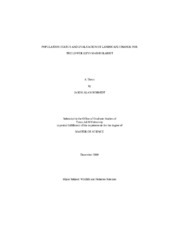| dc.description.abstract | Wildlife biologists and land managers tasked with the recovery of the endangered Lower Keys
marsh rabbit (LKMR; Sylvilagus palustris hefneri) were in need of a current population estimate as well as
a method to estimate the LKMR population annually. Habitat loss and fragmentation from population
growth and development have threatened the existence of the LKMR. Establishing and understanding
long-term habitat availability for the LKMR is important for determining causes of historical population
declines as well as designing and implementing successful recovery plans.
I conducted a range-wide pellet survey and a mark-recapture study to estimate the LKMR
population. I evaluated the fit of 5 models and considered the variation in behavioral response model the
best model. I correlated (r2 = 0.913) this model's rabbit abundance estimates to pellet density in 11
patches and generated a range-wide population estimate of 317, a western clade population of 257, an
eastern clade population of 25, and translocated LKMR populations of 35 and 0 on Little Pine and Water
keys, respectively. This prediction equation provides managers a quick, efficient, and non-invasive
method to estimate LKMR abundance from pellet counts.
To quantify the amount of habitat loss and fragmentation that occurred over the last 50 years, I
systematically delineated and compared potential LKMR habitat using 1959 and 2006 aerial photographs.
Additionally, I investigated if other factors could have reduced the amount of suitable habitat available for
the LKMR with a comparison of habitat loss and fragmentation on a developed island and an undeveloped
island. Range-wide, I found that number of habitat patches increased by 38, total class area decreased by
49.0%, and mean patch size decreased by 44.3%. Mean shape index increased by 4.2% and mean
proximity index decreased by 13%. Both the 1959 and 2006 connectance indices were low while the 2006
set decreased 12.1%. I observed the same patterns of habitat loss and fragmentation on both the developed
and undeveloped islands as I did in the range-wide landscape analysis. I found that LKMR habitat has
declined in area and become more fragmented over the last 50 years. Habitat loss and fragmentation by
development have directly endangered the LKMR; however, sea level rise and woody encroachment also could have historically caused habitat loss and fragmentation. Although development in LKMR habitat
was halted, sea-level rise and woody encroachment could continue to alter LKMR habitat. | en |


